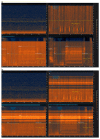Biological Sound vs. Anthropogenic Noise: Assessment of Behavioural Changes in Scyliorhinus canicula Exposed to Boats Noise
- PMID: 33451005
- PMCID: PMC7828510
- DOI: 10.3390/ani11010174
Biological Sound vs. Anthropogenic Noise: Assessment of Behavioural Changes in Scyliorhinus canicula Exposed to Boats Noise
Abstract
Despite the growing interest in human-made noise effects on marine wildlife, few studies have investigated the potential role of underwater noise on elasmobranch species. In this study, twelve specimens of small-spotted catshark (Scyliorhinus canicula) were exposed to biological and anthropogenic sounds in order to assess their behavioural changes in response to prey acoustic stimuli and to different amplitude levels of shipping noise. The sharks, individually held in aquariums, were exposed to four experimental acoustic conditions characterized by different spectral (Hz) components and amplitude (dB re 1 µPa) levels. The swimming behaviour and spatial distribution of sharks were observed. The results highlighted significant differences in swimming time and in the spatial use of the aquarium among the experimental conditions. When the amplitude levels of biological sources were higher than those of anthropogenic sources, the sharks' swimming behaviour was concentrated in the bottom sections of the aquarium; when the amplitude levels of anthropogenic sources were higher than biological ones, the specimens increased the time spent swimming. Moreover, their spatial distribution highlighted a tendency to occupy the least noisy sections of the aquarium. In conclusion, this study highlighted that anthropogenic noise is able to affect behaviour of catshark specimens and the impact depends on acoustic amplitude levels.
Keywords: anthropogenic noise; biological sounds; signal/noise ratio; small-spotted catshark.
Conflict of interest statement
The authors declare no conflict of interest.
Figures





Similar articles
-
Elasmobranch cognitive ability: using electroreceptive foraging behaviour to demonstrate learning, habituation and memory in a benthic shark.Anim Cogn. 2014 Jan;17(1):55-65. doi: 10.1007/s10071-013-0637-8. Epub 2013 Apr 26. Anim Cogn. 2014. PMID: 23620366
-
From subsea power cable to small-spotted catshark Scyliorhinus canicula: Behavioural effects of electromagnetic fields in tank experiments.Mar Environ Res. 2025 Jun;208:107127. doi: 10.1016/j.marenvres.2025.107127. Epub 2025 Apr 1. Mar Environ Res. 2025. PMID: 40209621
-
The effect of underwater sounds on shark behaviour.Sci Rep. 2019 May 6;9(1):6924. doi: 10.1038/s41598-019-43078-w. Sci Rep. 2019. PMID: 31061394 Free PMC article.
-
Potential interactions between diadromous fishes of U.K. conservation importance and the electromagnetic fields and subsea noise from marine renewable energy developments.J Fish Biol. 2012 Jul;81(2):664-95. doi: 10.1111/j.1095-8649.2012.03374.x. J Fish Biol. 2012. PMID: 22803729 Review.
-
A synthesis of two decades of research documenting the effects of noise on wildlife.Biol Rev Camb Philos Soc. 2016 Nov;91(4):982-1005. doi: 10.1111/brv.12207. Epub 2015 Jun 26. Biol Rev Camb Philos Soc. 2016. PMID: 26118691 Review.
Cited by
-
Sex Associated Effects of Noise Pollution in Stone Sculpin (Paracottus knerii) as a Model Object in the Context of Human-Induced Rapid Environmental Change.Biology (Basel). 2021 Oct 19;10(10):1063. doi: 10.3390/biology10101063. Biology (Basel). 2021. PMID: 34681163 Free PMC article.
References
-
- Buscaino G., Gavio A., Galvan D., Filiciotto F., Maccarrone V., de Vincenzi G., Mazzola S., Orensanz J. Acoustic signals and behaviour of Ovalipes trimaculatus in the context of reproduction. Aquat. Biol. 2015;24:61–73. doi: 10.3354/ab00636. - DOI
-
- Coquereau L., Grall J., Clavier J., Jolivet A., Chauvaud L. Acoustic behaviours of large crustaceans in NE Atlantic coastal habitats. Aquat. Biol. 2016;25:151–163. doi: 10.3354/ab00665. - DOI
-
- de Vincenzi G., Parisi I., Torri M., Papale E., Mazzola S., Nuth C., Buscaino G. Influence of environmental parameters on the use and spatiotemporal distribution of the vocalizations of bearded seals (Erignathus barbatus) in Kongsfjorden, Spitsbergen. Polar Biol. 2019;42:1241–1254. doi: 10.1007/s00300-019-02514-3. - DOI
-
- de Vincenzi G., Filiciotto F., Maccarrone V., Mazzola S., Buscaino G. Behavioural responses of the European spiny lobster, Palinurus elephas (Fabricius, 1787), to conspecific and synthetic sounds. Crustaceana. 2015;88:523–540. doi: 10.1163/15685403-00003430. - DOI
LinkOut - more resources
Full Text Sources
Other Literature Sources
Miscellaneous

